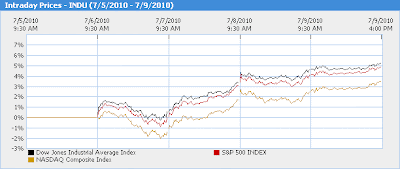The markets recorded their best returns of the year during this holiday-shortened week. At the Friday close, the Dow climbed 5.3%, the S&P popped 5.4%, and the Nasdaq rose 5.0%. Oil also had a big week, rising 5.5%, so gas prices will be higher at the pump. Gold recorded minor gains, although still off nearly 4% from its record high.
Source: MSN Moneycentral
It was quite an impressive week on Wall Street and we can’t point to exactly what caused the rise. Probably a combination of many little things contributed to the gains. Economic data was light; however, a few releases like retail sales and employment showed modest improvement. A lack of bad news certainly helped the mood on the street.
Being a holiday week, volume was very light, which usually results in more volatility in the market. That means the gains or losses become larger than they otherwise would be.
Short covering also contributed to the market rise. Traders who are betting the stock or the market will go down are considered “short”. In order to protect themselves from a rising market, they must repurchase those stocks. This pushes prices higher.
We think the largest contributor to the gains was an optimistic outlook for corporate earnings due to be released next week. Investors anticipate solid earnings from companies, and with the recent market pullback, now is a good time to get in before stocks (hopefully) head higher.
While we were pleased with the gains of the week, we are not reading much into it. As mentioned earlier, volume was light. If there was a higher volume of trades, it would show us a conviction in the rally. To make matters worse, investors pulled a considerable amount of money out of stock funds last week, while money market funds (which return practically nothing) saw significant inflows, followed by bond funds and foreign stock funds. This data makes us question the quality of the recent market gains.
Next Week
Next week will be a very busy and important one. Quarterly earnings season begins and over 20 stocks on the S&P 500, amongst numerous others, will have released their earnings. They will be compared to earnings of a year ago, when the economy was very weak, so earnings will undoubtedly be much higher. Accordingly, expectations are high. If they are not met or exceeded, we will likely see a sell-off.
While we agree that earnings will be high, we want to see a nice rise in revenue, not just earnings. See, revenue (what is actually received from the products or services they sell) can be flat, but if their costs are lower, earnings will be higher. So the company may not have increased sales, but if they lay off workers, for example, their costs are lower and their earnings are higher. A gain in revenue would indicate an improvement in sales and the economy, so that is what we are watching for.
In addition to corporate earnings, there are several economic reports we will be watching. Retail sales, business inventories, industrial production, and most importantly, producer price index (PPI), and consumer price index (CPI) will round out the week. These reports won’t impact the market as much as earnings, but will be important to follow, nonetheless.
Where are we investing now?
We will be closely watching earnings reports this week to get a gauge on the strength of the economy. Value investors who like to buy stocks trading at a “discount” (which we generally agree with) have been busy buying stocks recently. Until the employment picture clears up, we remain cautious. Still, a simple ladder of corporate bonds and bond funds looks like the least-scary investment.
Our big-picture outlook still remains the same, as we are optimistic through the end of the year. Low interest rates and stimulus funds will push the markets higher. The higher interest rates down the road, higher taxes, increasing government involvement in the private sector, and a still-high unemployment rate have us worried for the longer term.
In equities, we are focused on higher-quality and multi-national stocks, but some smaller stocks look promising, as well. We continue to avoid banking and insurance sector stocks, and new government regulations have us staying out of oil companies. TIPs are important as we expect inflation to increase in the future, while

